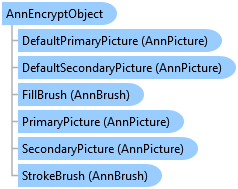| Leadtools.Windows.Annotations Namespace : AnnEncryptObject Class |

public class AnnEncryptObject : AnnRectangleObject, IAnnHeader, IAnnObject, IAnnPrimarySecondaryPicture, IAnnRectangle
'Declaration Public Class AnnEncryptObject Inherits AnnRectangleObject Implements IAnnHeader, IAnnObject, IAnnPrimarySecondaryPicture, IAnnRectangle
'Usage Dim instance As AnnEncryptObject
public ref class AnnEncryptObject : public AnnRectangleObject, IAnnHeader, IAnnObject, IAnnPrimarySecondaryPicture, IAnnRectangle
The encrypt annotation object is a rectangular object that is used to encrypt rectangular portions of an image.
It can also be used to encrypt the entire image. In design mode, the encrypt object is visible but partially transparent to show the part of the image that it covers. In run mode, the encrypt object is invisible.
You must call Apply to apply the encrypt object. Once applied, the portion of the image under the encrypt object becomes scrambled, and the encrypt object state changes to decryptor. Using different keys before calling this method gives different scrambling patterns. The decryptor state differs from the encryptor state in that a decryptor cannot be moved, and cannot be changed to an encryptor. The scrambling can be removed by calling Apply on the decrypt object with the appropriate arguments. If successful, the decryptor state changes to encryptor. An encrypt object in the encryptor state can be moved, can have its Key changed, and can be changed to a decrypt object.
The encrypt object is useful for encrypting portions of an image. After encrypting, the scrambled bitmap cannot easily be unscrambled without the associated annotation file. The scrambling can be removed by using the associated annotation file, or by using automation mode to manually change the state from encryptor to a decryptor, position it correctly, and setting the Key appropriately.
Overlapping regions can be encrypted. When encrypting overlapping regions, note the following points:
You cannot rotate an encrypt object, but you can flip or reverse it. If you rotate a container that includes an encrypt object, the encrypt object will move to the new position, but will retain its orientation.
This class implements the IAnnPrimarySecondaryPicture interface to handle primary and secondary pictures.
For more information, refer to Using Primary and Secondary Pictures in WPF Annotation Objects.
If you are interested in locking an object, refer to Implementing Annotation Security.
For more information about the encrypt annotation object refer to the AnnEncryptObject for WPF. For more information about the automated encrypt annotation object, refer to WPF Annotation Objects - Automated Features, WPF Automated Annotations - Encrypt Tab. and WPF Automated Annotations - Encrypt Pictures Tab.
 Copy Code
Copy Code
Imports Leadtools.Windows.Controls Imports Leadtools.Windows.Annotations '''<!--This example creates an encrypt object.--> Private Sub AnnEncryptObject_AnnEncryptObject(ByVal viewer As ImageViewer, ByVal container As AnnContainer) Dim encryptor As AnnEncryptObject = New AnnEncryptObject() encryptor.Rect = New Rect(100, 100, 300, 300) encryptor.Key = 123 encryptor.Encryptor = True container.Children.Add(encryptor) MessageBox.Show( _ String.Format("Added encryptor. Encryptor: {0}, IsEncrypted: {1}, CanEncrypt: {2}, CanDecrypt: {3}, Objects in container: {4}", _ encryptor.Encryptor, encryptor.IsEncrypted, encryptor.CanEncrypt, encryptor.CanDecrypt, container.Children.Count)) ' apply (encryptor) encryptor.Apply(viewer) MessageBox.Show( _ String.Format("Applied encryptor. Encryptor: {0}, IsEncrypted: {1}, CanEncrypt: {2}, CanDecrypt: {3}, Objects in container: {4}", _ encryptor.Encryptor, encryptor.IsEncrypted, encryptor.CanEncrypt, encryptor.CanDecrypt, container.Children.Count)) ' remove from the container container.Children.Remove(encryptor) MessageBox.Show(String.Format("Removed encryptor. Objects in container: {0}", container.Children.Count)) ' create another encrypt object to decrypt the first object Dim decryptor As AnnEncryptObject = New AnnEncryptObject() decryptor.Rect = New Rect(100, 100, 300, 300) decryptor.Key = 123 decryptor.Encryptor = False container.Children.Add(decryptor) MessageBox.Show(String.Format( _ "Added decryptor. Encryptor: {0}, IsEncrypted: {1}, CanEncrypt: {2}, CanDecrypt: {3}, Objects in container: {4}", _ decryptor.Encryptor, decryptor.IsEncrypted, decryptor.CanEncrypt, decryptor.CanDecrypt, container.Children.Count)) ' apply (decryptor) decryptor.Apply(viewer) MessageBox.Show(String.Format( _ "Applied decryptor. Encryptor: {0}, IsEncrypted: {1}, CanEncrypt: {2}, CanDecrypt: {3}, Objects in container: {4}", _ decryptor.Encryptor, decryptor.IsEncrypted, decryptor.CanEncrypt, decryptor.CanDecrypt, container.Children.Count)) ' remove from the container container.Children.Remove(decryptor) MessageBox.Show(String.Format("Removed decryptor. Objects in container: {0}", container.Children.Count)) End Sub
using Leadtools.Windows.Controls; using Leadtools.Windows.Annotations; using Leadtools.Demos; using Leadtools.Help; private void AnnEncryptObject_AnnEncryptObject(ImageViewer viewer, AnnContainer container) { AnnEncryptObject encryptor = new AnnEncryptObject(); encryptor.Rect = new Rect(100, 100, 300, 300); encryptor.Key = 123; encryptor.Encryptor = true; container.Children.Add(encryptor); MessageBox.Show(String.Format("Added encryptor. Encryptor: {0}, IsEncrypted:"+ "{1}, CanEncrypt: {2}, CanDecrypt: {3}, Objects in container: {4}", encryptor.Encryptor, encryptor.IsEncrypted, encryptor.CanEncrypt, encryptor.CanDecrypt, container.Children.Count)); // apply (encryptor) encryptor.Apply(viewer); MessageBox.Show(String.Format("Applied encryptor. Encryptor:"+ "{0}, IsEncrypted: {1}, CanEncrypt: {2}, CanDecrypt: {3}, Objects in container: {4}", encryptor.Encryptor, encryptor.IsEncrypted, encryptor.CanEncrypt, encryptor.CanDecrypt, container.Children.Count)); // remove from the container container.Children.Remove(encryptor); MessageBox.Show(String.Format("Removed encryptor. Objects in container: {0}", container.Children.Count)); // create another encrypt object to decrypt the first object AnnEncryptObject decryptor = new AnnEncryptObject(); decryptor.Rect = new Rect(100, 100, 300, 300); decryptor.Key = 123; decryptor.Encryptor = false; container.Children.Add(decryptor); MessageBox.Show(String.Format("Added decryptor. Encryptor:"+ "{0}, IsEncrypted: {1}, CanEncrypt: {2}, CanDecrypt: {3}, Objects in container: {4}", decryptor.Encryptor, decryptor.IsEncrypted, decryptor.CanEncrypt, decryptor.CanDecrypt, container.Children.Count)); // apply (decryptor) decryptor.Apply(viewer); MessageBox.Show(String.Format("Applied decryptor. Encryptor:"+ "{0}, IsEncrypted: {1}, CanEncrypt: {2}, CanDecrypt: {3}, Objects in container: {4}", decryptor.Encryptor, decryptor.IsEncrypted, decryptor.CanEncrypt, decryptor.CanDecrypt, container.Children.Count)); // remove from the container container.Children.Remove(decryptor); MessageBox.Show(String.Format("Removed decryptor. Objects in container: {0}", container.Children.Count)); }